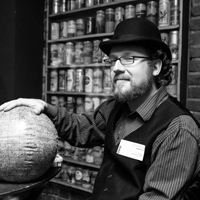The large objects in the Solar System — the Sun, planets, big moons — grab more than their share of the glory. Yet smaller bodies, including comets and asteroids, are exceedingly important if we want to understand the origins of the Solar System. That’s because these objects are often pristine in a chemical sense: they haven’t changed much over the last 4.5 billion years or more.
But comets, thanks to their eccentric and frequently long orbits, are trickier to study up close. That’s the mission of the European Space Agency’s Rosetta spacecraft: this week, the probe settled into orbit around Comet 67P/Churyumov–Gerasimenko. Anytime we reach a new world to study it’s exciting, but this is particularly interesting because it will be the first long-term study of a comet — including a lander to collect samples of the surface material.
Comets have been known since antiquity: streaks of whitish light stretching across the sky that come and go over the course of days. Unlike the regular cycles of planets or the challenging yet still predictable pattern of eclipses, comets seemed to come and go randomly. No wonder they were often considered bad omens: no soothsayer could tell when one might appear.
Thanks to centuries of astronomical study, we’ve learned that some comets — like the famous Halley’s comet — do return again and again, while others are one-time visitors. Instead of harbingers of doom, comets have joined the general census of Solar System objects, with planets, asteroids, and other interesting bodies.
What we primarily see is the clothing of the actual comet: its tail is a flowing robe of melted ice (consisting of water, carbon dioxide, and other familiar chemicals) and dust knocked off by particles streaming out from the Sun. While it may stretch a long way, that robe contains relatively little material. The body beneath is a chunk of ice and dust and interesting complex chemical compounds, such as amino acids; studying that body is the goal of Rosetta.
That’s because comets are still mysterious in many ways: they’re just too small for close observation. Comet 67P is only about 5 kilometers (3 miles) across on its longest dimension, which is a shorter distance than many of us travel to work. Taken in the context of how big the Solar System is, it takes very careful maneuvering for a space probe to get close enough to study a comet. For that reason, Comet 67P is only the sixth comet to be studied by spacecraft, and the first where a probe is going to remain in orbit, as opposed to flying by.
In fact, “orbit” isn’t quite the right word: Comet 67P’s gravity is too weak to keep Rosetta in orbit. Instead, the probe is making a serious of weird triangular swoops around the comet, using its thrusters to compensate for the role gravity would usually play. To get into this complex orbit, Rosetta needed 10 years from its launch to achieve the right speed and direction.
To make things even more fun, Comet 67P isn’t anywhere close to spherical. Its shape has variously been compared to a sphinx or a rubber ducky, but in slightly more scientific terms, the comet consists of two irregular lumps joined by a smooth “neck”. Other comets we’ve observed are also irregular, though not quite as weird as this one. Researchers aren’t sure yet whether Comet 67P is the result of two comets that stuck together, or if once was more regular and was slowly eroded as ice melted away.
Rosetta may be able to answer that question, and many others besides. If all goes as planned, the probe will remain in its orbit for at least a year, which means it can monitor any changes in the comet’s surface. Earlier spacecraft observed changes in other comets over short periods of time, so Rosetta should see a lot more as Comet 67P swoops closer to the Sun on its 6.5-year orbit.
Beyond that, Rosetta carries the Philae lander, which is a small three-legged probe that will anchor itself to the comet sometime later this year. Among Philae’s scientific instruments is a drill to take surface samples, for a fuller chemical analysis than can be achieved from orbit.
(Again, Comet 67P’s gravity is so weak, the probe needs to grapple it to stay put. Rhett Allain did a quick simplified calculation showing that a human couldn’t even walk on the comet without launching themselves off the surface!)
Comets contain amino acids, which are organic compounds that include the raw ingredients for proteins that make for living things. It’s possible that comets helped seed the early Earth with those chemicals, during an intense period of bombardment as the Solar System formed. For that reason, Rosetta and Philae might help us understand the chemical origins of life on Earth.
So don’t be fooled into thinking that Comet 67P’s small size means it’s insignificant. Thanks to Rosetta, we stand to learn as much about comets in a matter of months as we have in centuries of study.






